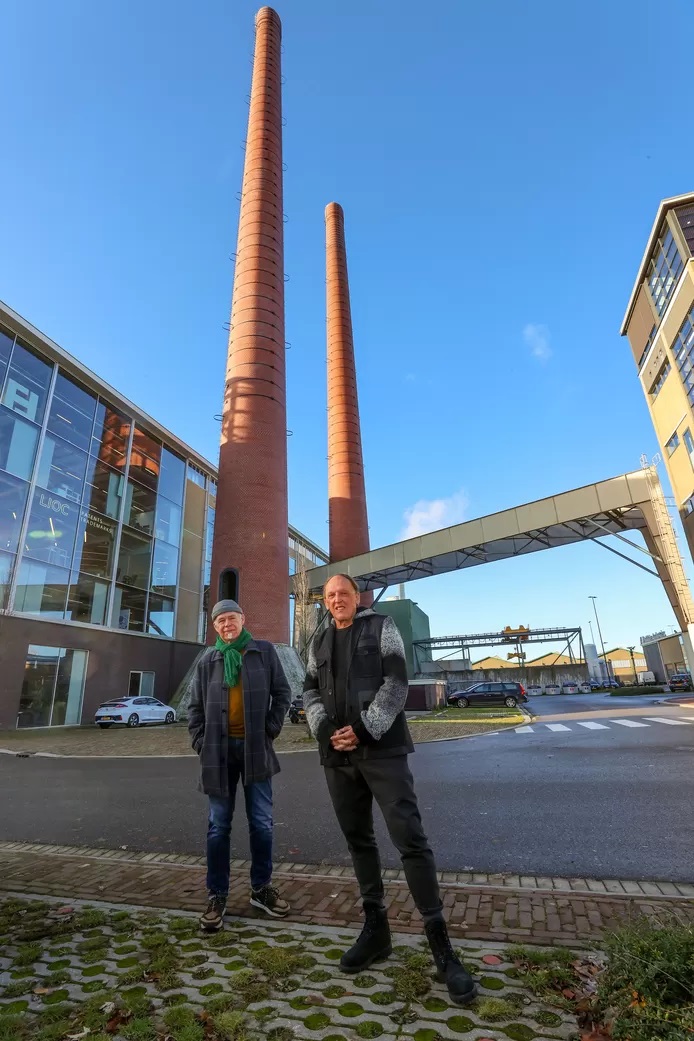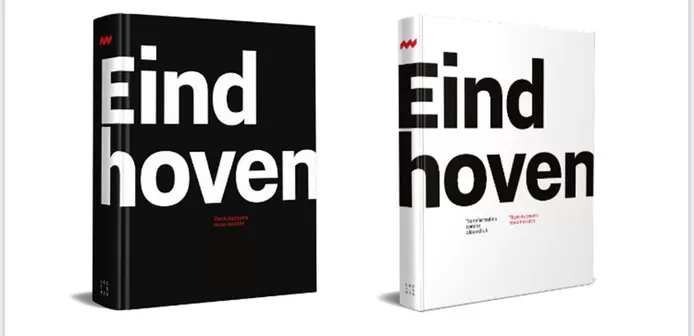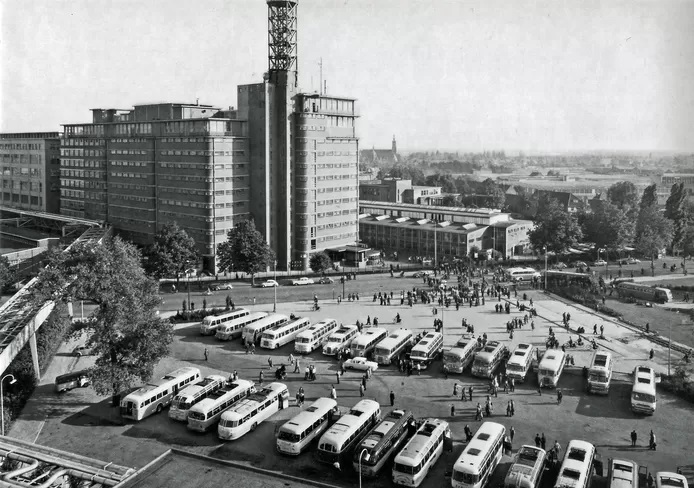18 december 2021
Leuke weetjes en de grote lijn: twee dikke 'zap’-pillen over geschiedenis van Groot Eindhoven 1920-2020
EINDHOVEN - Bij de viering van het eerste kampioenschap van PSV in 1929 maakten Anton Philips en de gemeente Eindhoven ruzie, over de route van de platte kar bij de huldiging. Natuurlijk moest die eerst bij de Philips’ landhuis De Laak langs komen. Het is typerend voor de verhouding tussen Eindhoven en Philips, schrijven Thom Aussems en Hans Horsten in hun boek Eindhoven, over de geschiedenis van de stad.

Hans Horsten (links) en Thom Aussems hebben een boek geschreven over 100 jaar Groot Eindhoven 1920-2020. © Bert Jansen/DCI-Media
800 boeken en 3000 krantenartikelen raadpleegden de schrijvers. 2000 foto's uit het Philips Archief en van bekende fotografen zoals Norbert van Onna en Martien Coppens gebruiken ze. 1075 onderwerpen behandelen ze met ieder een eigen tekst. Dat leidde tot twee dikke pillen die in totaal zo'n 1260 pagina's de geschiedenis van Groot Eindhoven 1920-2020 behandelen.
Het is een echt zap-boek
Maar wie gaat dat allemaal lezen? Niemand, grappen Thom Aussems en Hans Horsten, die tekenen voor het boek. ,,Maar het is dan ook een zap-boek. Je kunt er op een regenachtige zondagmiddag in bladeren, losse stukjes lezen en als je meer wilt weten, kun je dat elders in de boeken vinden. Bovendien staan er heel veel foto's in. Soms ook pagina's vol over bepaalde thema's, zoals de Philips Kumpanytown", aldus Aussems. Horsten heeft als schrijver/eindredacteur de oud-Trudo-directeur nog ‘kort’ moeten houden. Geholpen door vormgever Marc Koppen.
Aanleiding voor het boek is het honderdjarig bestaan van Eindhoven. In 1920 werden de gemeenten Eindhoven, Gestel, Stratum, Strijp, Tongelre en Woensel samengevoegd. De viering in 2020 werd door de coronamaatregelen danig in de war gestuurd. Ook Aussems en Horsten hadden er veel last van. Archieven waren bijvoorbeeld niet toegankelijk. ,,Dus heb ik 6000 euro uitgegeven om 800 boeken aan te schaffen. Maar toen zat ik in Portugal, waar ik regelmatig woon. Maandenlang kon ik niet naar Eindhoven. Dus hebben we de boeken in twintig verhuisdozen naar Portugal moeten verschepen”, vertelt Aussems.
 De twee boeken die samen de geschiedenis van Groot Eindhoven 1920-2020 beschrijven. © Uitgeverij Lecturis/ontwerp Marc Koppen
De twee boeken die samen de geschiedenis van Groot Eindhoven 1920-2020 beschrijven. © Uitgeverij Lecturis/ontwerp Marc Koppen
Allemaal bijkomende kosten, die voor een deel door de gemeente en deels door sponsors zijn opgebracht. Maar vooral de almaar uitdijende omvang maakten het project duurder. Uiteindelijk werden het twee boeken - technisch kon het ook niet anders - en moest de oplage omhoog om het enigszins betaalbaar te houden. Veertig euro bleek geen haalbare kaart, maar dankzij donaties blijft de prijs van deel een beperkt tot 50 euro. Daarvan zijn er al 3700 besteld, van deel twee 2400.
In het eerste boek wordt de hele geschiedenis in 1075 hoofdstukjes behandeld, verdeeld over een aantal tijdvakken van 1815 tot 2020. 1815 om te begrijpen waarom Philips hier grote aantallen goedkope arbeidskrachten kon vinden. Met de komst van Philips in 1891, de Tweede Wereldoorlog en de operatie Centurion met de ontslagen bij Philips als grote breekpunten. Steeds wordt de de stand van de economie, de staat van de fysieke stad en de quality of life, de sociaal-maatschappelijke kant belicht.
In deel twee komt dan de grotere lijn aan bod: Eindhoven is geen eiland, maar onderdeel van de wereldgeschiedenis en de trends die daarin spelen. ,,In deel één kun je aardige stukjes lezen. Over het eerste stoplicht bijvoorbeeld. Een lullig klein feitje dat onderdeel is van de stedelijke ontwikkeling. In deel twee zie je meer hoe dat is gegroeid en is ontstaan”, aldus Horsten.
 Met VIPRE-bussen werd het personeel van Philips en DAF in Eindhoven aangevoerd; hier staan ze opgesteld bij de poort aan de Beukenlaan, bij het Veemgebouw. © Huub Jacobs
Met VIPRE-bussen werd het personeel van Philips en DAF in Eindhoven aangevoerd; hier staan ze opgesteld bij de poort aan de Beukenlaan, bij het Veemgebouw. © Huub Jacobs
Moest dat nou zo uitvoerig? ,,Ja, dat moest. Want als ik eraan begin, dan moet het wel kloppen", zegt Aussems. ,,Er is natuurlijk al veel over Eindhoven geschreven, maar dit boek is behoorlijk compleet. Al zullen we er nog wel achter komen dat we iets vergeten zijn", vult Horsten aan.
Aussems weer: ,,En als je iets opneemt, wil je ook uitleggen waarom dat zo is. Een voorbeeld? We ontdekten bijvoorbeeld dat de deken van de katholieke kerk van Eindhoven na de oorlog ineens op feestelijke recepties van Philips kwam. Terwijl dat voor de oorlog water en vuur was. De bijna fundamentalistische kerk werkte de niet-katholieke familie Philips tegen. De Roomse bladen schreven over Anton Philips alsof hij de baarlijke duivel was. Toen vonden we in een katholiek weekblad van na de oorlog een artikel met kop in chocoladeletters dat Frits Philips alle pastoors had rondgeleid en onthaald op een diner. Ook kregen alle kerken een geluidsinstallatie. Toen was het ijs gebroken. Sindsdien is de verstandhouding sterk verbeterd.”
Vier artikelen in het Z-katern van het ED
Het zijn van die weetjes die Aussems en Horsten boven water gehaald hebben. Leuke feiten die een andere kijk op de historie geven. Maar ze houden zeker ook de grote lijn in de gaten. Dat blijkt ook in de verhalen die de komende weken in het Z-katern van deze krant staan. Dat zijn thematische verhalen, speciaal geschreven voor het ED. ,,Daarin behandelen we een aantal thema's, met materiaal waarvoor we de teksten in ons boek hebben geplunderd", zegt Horsten.
Een van die onderwerpen is de altijd moeizame 'kribbige’ relatie tussen die gemeente Groot Eindhoven en Philips. Een klein voorbeeld: bij het eerste kampioenschap van PSV ruzieden de twee over de rondrit. ,,Hier is het idee voor de platte kar al geboren", zegt Aussems. ,,Maar Anton eiste dat ze eerst bij zijn villa De Laak in Tongelre langs kwamen en dan pas bij het gemeentebestuur. Hij was piswoest toen dat niet lukte.” Pas onder Frits Philips kwam het weer een beetje goed met de verhoudingen.
De stelling is dat het bedrijf zijn eigen, particuliere verzorgingsstaat heeft opgebouwd, met gezondheidszorg, culturele voorzieningen, sportverenigingen, woningbouw, studiebeurzen en ga zo maar door. Om aantrekkelijk te zijn voor de vele medewerkers die de ‘kumpany' nodig had. ,,Maar ook simpelweg omdat de gemeente er nooit in slaagde de industrie van toen te accommoderen, vertelt Aussems.
,,En dat lukt nog steeds niet. Ook nu zijn de voorzieningen in Eindhoven onvoldoende en moeten bedrijven als ASML zelf bijspringen. Dat is een rode draad in de Eindhovense geschiedenis.” Ook willen ze in de artikelen een doorkijkje naar de toekomst opnemen. ,,In 1898 was het Eindhoven Vooruit, een groep van vooruitstrevende fabrikanten, die de stad vooruit wilden helpen. Wie doet dat anno nu? En hoe zorgen we er bijvoorbeeld voor dat ASML de productie niet naar het buitenland verplaatst, zoals Philips dat ook heeft gedaan omdat het publieke domein onvoldoende voorzieningen wist te realiseren”, aldus de auteur.
Presentatie, podcasts en tentoonstelling
Het boek wordt in een aantal bijeenkomsten gepresenteerd, aan vertegenwoordigers van het bedrijfsleven op 12 januari, aan de gemeenteraad op 25 januari en aan invloedrijke Eindhovenaren op 26 januari. Ook komen er nog een serie podcasts, live opgenomen met publiek, over het boek. En dan is er begin volgend jaar nog de expositie Eindhoven 1920-2020, die verplaatst is naar de gangen van gebouwen TQ en Innovation Powerhouse op Strijp-T.
De boeken zijn te bestellen via de site van uitgeverij Lecturis of in boekhandel Van Piere. Deel 1 met de titel Eindhoven kost 50 euro, deel 2, Transformaties zonder blauwdruk, 25 euro.